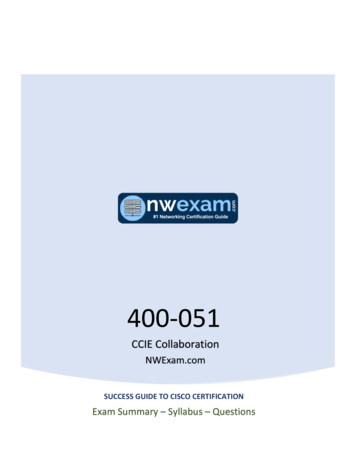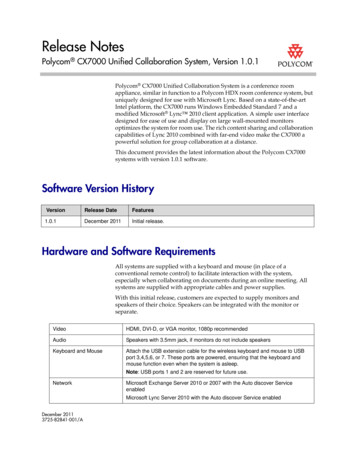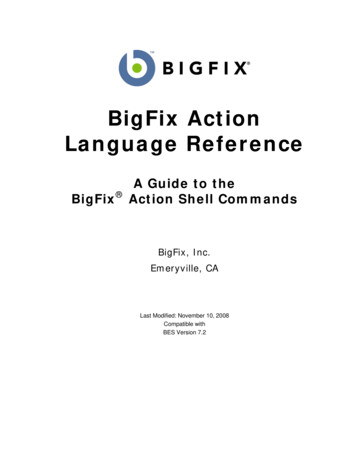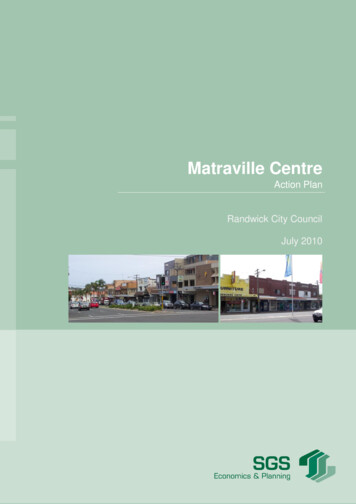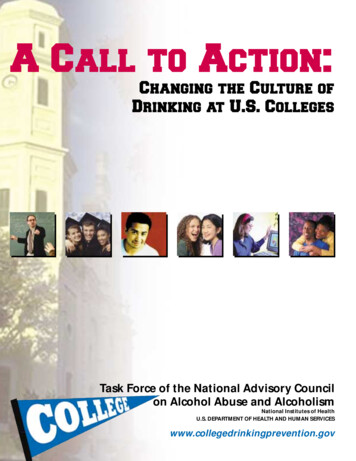
Transcription
A Call to Action:Changing the Culture ofDrinking at U.S. CollegesTask Force of the National Advisory Councilon Alcohol Abuse and AlcoholismNational Institutes of HealthU.S. DEPARTMENT OF HEALTH AND HUMAN SERVICESwww.collegedrinkingprevention.gov
A Call to Action:Changing the Culture ofDrinking at U.S. CollegesApril 2002National Institute on AlcoholAbuse and Alcoholism
ContentsSpecial Thanks to Enoch Gordis, M.D. . . . . . . . . . . . . . . . . . . . . . . . . . . . . . . . . . . . . . . . . . . . . . . . . . . . . . . . . . . . . . . . . . . . . . . . .vComment from the Institute . . . . . . . . . . . . . . . . . . . . . . . . . . . . . . . . . . . . . . . . . . . . . . . . . . . . . . . . . . . . . . . . . . . . . . . . . . . . . . .viiPreface . . . . . . . . . . . . . . . . . . . . . . . . . . . . . . . . . . . . . . . . . . . . . . . . . . . . . . . . . . . . . . . . . . . . . . . . . . . . . . . . . . . . . . . . . . . . . . . .ixTask Force Co-Chairs . . . . . . . . . . . . . . . . . . . . . . . . . . . . . . . . . . . . . . . . . . . . . . . . . . . . . . . . . . . . . . . . . . . . . . . . . . . . . . . . . . .ixIntroduction . . . . . . . . . . . . . . . . . . . . . . . . . . . . . . . . . . . . . . . . . . . . . . . . . . . . . . . . . . . . . . . . . . . . . . . . . . . . . . . . . . . . . . . . . . . .1College Drinking Is a Culture . . . . . . . . . . . . . . . . . . . . . . . . . . . . . . . . . . . . . . . . . . . . . . . . . . . . . . . . . . . . . . . . . . . . . . . . . . . . .1The Answer: Change the Culture. The Question: How? . . . . . . . . . . . . . . . . . . . . . . . . . . . . . . . . . . . . . . . . . . . . . . . . . . . . . . . . . .2A Snapshot of Annual High-Risk College Drinking Consequences . . . . . . . . . . . . . . . . . . . . . . . . . . . . . . . . . . . . . . . . . . . . . . . . . .4Heavy Episodic Consumption of Alcohol . . . . . . . . . . . . . . . . . . . . . . . . . . . . . . . . . . . . . . . . . . . . . . . . . . . . . . . . . . . . . . . . . . . . . . .5Alcohol and Adolescent Brain Development . . . . . . . . . . . . . . . . . . . . . . . . . . . . . . . . . . . . . . . . . . . . . . . . . . . . . . . . . . . . . . . . . . . . .7Factors Affecting Student Drinking . . . . . . . . . . . . . . . . . . . . . . . . . . . . . . . . . . . . . . . . . . . . . . . . . . . . . . . . . . . . . . . . . . . . . . . . . . .8Living Arrangements . . . . . . . . . . . . . . . . . . . . . . . . . . . . . . . . . . . . . . . . . . . . . . . . . . . . . . . . . . . . . . . . . . . . . . . . . . . . . . . . . . . .8College Characteristics . . . . . . . . . . . . . . . . . . . . . . . . . . . . . . . . . . . . . . . . . . . . . . . . . . . . . . . . . . . . . . . . . . . . . . . . . . . . . . . . . . .8First-Year Students . . . . . . . . . . . . . . . . . . . . . . . . . . . . . . . . . . . . . . . . . . . . . . . . . . . . . . . . . . . . . . . . . . . . . . . . . . . . . . . . . . . . . .8Other Factors Affecting Drinking . . . . . . . . . . . . . . . . . . . . . . . . . . . . . . . . . . . . . . . . . . . . . . . . . . . . . . . . . . . . . . . . . . . . . . . . . . .9Comparison with Noncollege Peers . . . . . . . . . . . . . . . . . . . . . . . . . . . . . . . . . . . . . . . . . . . . . . . . . . . . . . . . . . . . . . . . . . . . . . . . .9Secondhand Consequences of Drinking . . . . . . . . . . . . . . . . . . . . . . . . . . . . . . . . . . . . . . . . . . . . . . . . . . . . . . . . . . . . . . . . . . . . . .9Post-College Consequences . . . . . . . . . . . . . . . . . . . . . . . . . . . . . . . . . . . . . . . . . . . . . . . . . . . . . . . . . . . . . . . . . . . . . . . . . . . . . . .9Issues Involved in A Call to Action . . . . . . . . . . . . . . . . . . . . . . . . . . . . . . . . . . . . . . . . . . . . . . . . . . . . . . . . . . . . . . . . . . . . . . . . . .10The Challenge for Colleges and Communities . . . . . . . . . . . . . . . . . . . . . . . . . . . . . . . . . . . . . . . . . . . . . . . . . . . . . . . . . . . . . . . .10Impact of Inadequate Information . . . . . . . . . . . . . . . . . . . . . . . . . . . . . . . . . . . . . . . . . . . . . . . . . . . . . . . . . . . . . . . . . . . . . .11Problems with Program Design . . . . . . . . . . . . . . . . . . . . . . . . . . . . . . . . . . . . . . . . . . . . . . . . . . . . . . . . . . . . . . . . . . . . . . . .11Impact on Implementation . . . . . . . . . . . . . . . . . . . . . . . . . . . . . . . . . . . . . . . . . . . . . . . . . . . . . . . . . . . . . . . . . . . . . . . . . . .11Results of Prolonged Ineffectiveness . . . . . . . . . . . . . . . . . . . . . . . . . . . . . . . . . . . . . . . . . . . . . . . . . . . . . . . . . . . . . . . . . . . . .11Integrating Research Into College Alcohol Program Planning . . . . . . . . . . . . . . . . . . . . . . . . . . . . . . . . . . . . . . . . . . . . . . . . . . . . .12Involving Colleges and Universities . . . . . . . . . . . . . . . . . . . . . . . . . . . . . . . . . . . . . . . . . . . . . . . . . . . . . . . . . . . . . . . . . . . . . . . .12Establishing Administrative Norms . . . . . . . . . . . . . . . . . . . . . . . . . . . . . . . . . . . . . . . . . . . . . . . . . . . . . . . . . . . . . . . . . . . . . .13Obtaining External Support . . . . . . . . . . . . . . . . . . . . . . . . . . . . . . . . . . . . . . . . . . . . . . . . . . . . . . . . . . . . . . . . . . . . . . . . . . .13A Call to Action: Recommendations for Addressing Excessive College Drinking . . . . . . . . . . . . . . . . . . . . . . . . . . . . . . . . . . . . . . . . .14Recommendations for Colleges and Universities . . . . . . . . . . . . . . . . . . . . . . . . . . . . . . . . . . . . . . . . . . . . . . . . . . . . . . . . . . . . . . .14Overarching Framework . . . . . . . . . . . . . . . . . . . . . . . . . . . . . . . . . . . . . . . . . . . . . . . . . . . . . . . . . . . . . . . . . . . . . . . . . . . . . .14Recommended Strategies . . . . . . . . . . . . . . . . . . . . . . . . . . . . . . . . . . . . . . . . . . . . . . . . . . . . . . . . . . . . . . . . . . . . . . . . . . . . . . . .15Tier 1: Evidence of Effectiveness Among College Students . . . . . . . . . . . . . . . . . . . . . . . . . . . . . . . . . . . . . . . . . . . . . . . . . . . . .16Tier 2: Evidence of Success With General Populations That Could Be Applied to College Environments . . . . . . . . . . . . . . . . . .17Tier 3: Evidence of Logical and Theoretical Promise, But Require More Comprehensive Evaluation . . . . . . . . . . . . . . . . . . . . . .20Tier 4: Evidence of Ineffectiveness . . . . . . . . . . . . . . . . . . . . . . . . . . . . . . . . . . . . . . . . . . . . . . . . . . . . . . . . . . . . . . . . . . . . . .23A Special Role for College Presidents . . . . . . . . . . . . . . . . . . . . . . . . . . . . . . . . . . . . . . . . . . . . . . . . . . . . . . . . . . . . . . . . . . . . . . . . .25The Need for Student Participation in Prevention Policymaking and Programs . . . . . . . . . . . . . . . . . . . . . . . . . . . . . . . . . . . . . . . . . .26Recommendations for the Research Community . . . . . . . . . . . . . . . . . . . . . . . . . . . . . . . . . . . . . . . . . . . . . . . . . . . . . . . . . . . . . . . .28Recommendations for NIAAA . . . . . . . . . . . . . . . . . . . . . . . . . . . . . . . . . . . . . . . . . . . . . . . . . . . . . . . . . . . . . . . . . . . . . . . . . . . . . .29A Final Word . . . . . . . . . . . . . . . . . . . . . . . . . . . . . . . . . . . . . . . . . . . . . . . . . . . . . . . . . . . . . . . . . . . . . . . . . . . . . . . . . . . . . . . . . .32References . . . . . . . . . . . . . . . . . . . . . . . . . . . . . . . . . . . . . . . . . . . . . . . . . . . . . . . . . . . . . . . . . . . . . . . . . . . . . . . . . . . . . . . . . . . . .33Task Force Members and Participants . . . . . . . . . . . . . . . . . . . . . . . . . . . . . . . . . . . . . . . . . . . . . . . . . . . . . . . . . . . . . . . . . . . . . . . .45College and University Presidents . . . . . . . . . . . . . . . . . . . . . . . . . . . . . . . . . . . . . . . . . . . . . . . . . . . . . . . . . . . . . . . . . . . . . . . . . .45Special Thanks to Other Participating College Presidents . . . . . . . . . . . . . . . . . . . . . . . . . . . . . . . . . . . . . . . . . . . . . . . . . . . . . . . .45Researchers . . . . . . . . . . . . . . . . . . . . . . . . . . . . . . . . . . . . . . . . . . . . . . . . . . . . . . . . . . . . . . . . . . . . . . . . . . . . . . . . . . . . . . . . . .46Task Force Panel Members . . . . . . . . . . . . . . . . . . . . . . . . . . . . . . . . . . . . . . . . . . . . . . . . . . . . . . . . . . . . . . . . . . . . . . . . . . . . . . .46Students . . . . . . . . . . . . . . . . . . . . . . . . . . . . . . . . . . . . . . . . . . . . . . . . . . . . . . . . . . . . . . . . . . . . . . . . . . . . . . . . . . . . . . . . . . . .47National Institute on Alcohol Abuse and Alcoholism . . . . . . . . . . . . . . . . . . . . . . . . . . . . . . . . . . . . . . . . . . . . . . . . . . . . . . . . . . .47Contributors . . . . . . . . . . . . . . . . . . . . . . . . . . . . . . . . . . . . . . . . . . . . . . . . . . . . . . . . . . . . . . . . . . . . . . . . . . . . . . . . . . . . . . . . .47Resources . . . . . . . . . . . . . . . . . . . . . . . . . . . . . . . . . . . . . . . . . . . . . . . . . . . . . . . . . . . . . . . . . . . . . . . . . . . . . . . . . . . . . . . . . . . . .48Commissioned Papers . . . . . . . . . . . . . . . . . . . . . . . . . . . . . . . . . . . . . . . . . . . . . . . . . . . . . . . . . . . . . . . . . . . . . . . . . . . . . . . . . . . .49Panel 1—Contexts and Consequences . . . . . . . . . . . . . . . . . . . . . . . . . . . . . . . . . . . . . . . . . . . . . . . . . . . . . . . . . . . . . . . . . . . . . .49Panel 2—Prevention and Treatment . . . . . . . . . . . . . . . . . . . . . . . . . . . . . . . . . . . . . . . . . . . . . . . . . . . . . . . . . . . . . . . . . . . . . . . .50Joint Panel Papers . . . . . . . . . . . . . . . . . . . . . . . . . . . . . . . . . . . . . . . . . . . . . . . . . . . . . . . . . . . . . . . . . . . . . . . . . . . . . . . . . . . . .51III
Special Thanks to Enoch Gordis, M.D.The Task Force wishes to extend a special thank you to Dr. Enoch Gordis for his leadership and dedication. Dr.Gordis stepped down as Director of NIAAA on December 30, 2001, after 15 years of outstanding leadership. Hewas the inspiration for this project, citing the lack of research on this important public health problem. “Fordecades, there has been meeting after meeting that offered plausible, intelligent recommendations, all with noevaluations. Then, when these programs fail to work, meetings are again convened to ponder the same questions.Only through a commitment to research can we truly begin to understand what can and cannot be done, so that infive or ten years we don’t find ourselves asking the same questions yet again.” In light of his vision, we offer thisreport as a beginning.V
Comment from the InstituteEvery year as spring break approaches or when another promising young student dies in an alcohol-related tragedy,college drinking becomes a national issue. Although excessive drinking by college students is accepted as a rite ofpassage by many, alcohol-related tragedies never fail to shock us and to prompt calls for immediate action. Whenschools respond with well-intentioned programs, but the problem persists, it is natural to wonder how much we reallyunderstand about excessive, college student drinking. Is it inevitable? Can we take steps to prevent it or reduce itsconsequences? Why have efforts to date proven ineffective?The fact is that since 1976, when the newly created National Institute on Alcohol Abuse and Alcoholism (NIAAA)issued its only report on abusive drinking by college students, research advances have transformed our understandingof alcohol abuse and related problems. For example, we now know that a broad array of factors affect college studentdrinking behavior. These include an individual’s susceptibility to alcohol, campus norms related to drinking, andconditions within the larger community that make alcohol readily accessible and fail to penalize inappropriate use.Together these influences contribute to a culture of drinking that is more damaging and deadly than previouslyrecognized.This report, developed by the NIAAA-supported Task Force on College Drinking after 3 years of intensivediscussions, describes our new understanding of dangerous drinking behavior by college students and its consequencesfor both drinkers and nondrinkers. Rather than debate how many drink how much, the Task Force focused on theconsequences. What it found challenges many common assumptions about the size and nature of the problem. Notonly do some 1,400 college students between the ages of 18 and 24 die every year as a result of hazardous drinking,but a half million suffer unintentional injuries under the influence of alcohol. Another 600,000 are assaulted by fellowdrinking students and more than 70,000 are sexually assaulted. The data on academic achievement, damage tofacilities, and health problems are equally alarming. The nature of existing data leads to the inference that somecollege students meet the diagnostic criteria for alcohol dependence as currently specified by the American PsychiatricAssociation’s Diagnostic and Statistical Manual of Mental Disorders, 4th edition (DSM-IV), but are not receivingtreatment. Although most students who exhibit dangerous drinking behavior during their college career mature out ofheavy drinking, this behavior and its consequences are nonetheless cause for concern.In its report, the Task Force outlines a series of recommendations for colleges and universities, researchers, andNIAAA. What distinguishes this guidance from others is its firm reliance on scientific evidence and its call forcollaboration between academic institutions and researchers. In response to the information and recommendations inthis report, NIAAA is committing an additional 8 million over the next two fiscal years to the issue of collegedrinking. It also is collaborating with several college presidents to determine the effectiveness of policies aimed atreducing the problem.The chancellor of a university that recently suffered the alcohol-related death of one of its students said, “Ourchildren’s lives are at real risk, and universities need to make every effort to prevent any more lives from beingwasted.” This report underscores the wisdom of that advice and urges us to join forces in changing the culture ofdrinking on our Nation’s campuses from one that fosters destructive behavior to one that discourages it.Raynard Kington, M.D., Ph.D., M.B.A.Acting DirectorNational Institute on Alcohol Abuse and AlcoholismVII
PrefaceTask Force Co-ChairsThe Task Force on College Drinking, a group ofdistinguished educators, alcohol researchers, andstudents, has been meeting for 3 years to respond to thepersistent and pervasive problem of excessive drinking bystudents on U.S. college campuses. The Task Force wasestablished by the National Advisory Council onAlcohol Abuse and Alcoholism. Although NIAAA hasmaintained a modest portfolio of grants on collegedrinking for many years, the Task Force represents aneffort to address the issue in the most coordinated andcomprehensive way possible.The goals of the Task Force are threefold:1. Provide research-based information about thenature and extent of dangerous drinking to highschool and college administrators, students,parents, community leaders, policymakers,researchers, and members of the retail beverageindustry;2. Offer recommendations to college and universitypresidents on the potential effectiveness of currentstrategies to reverse the culture of drinking oncampus; and3. Offer recommendations to the research community,including NIAAA, for future research onpreventing hazardous college student drinking.To this end, the Task Force conducted acomprehensive review of research on drinking by collegestudents and on strategies to prevent it. We establishedtwo panels that addressed: (1) the contexts in whichcollege drinking occurs and its consequences, and(2) prevention and treatment. In addition to extensivedeliberations, the panels commissioned 24 originalscientific papers intended to synthesize what we knowand identify research gaps. Most of these papers arebeing published in a special supplement to the Journal ofStudies on Alcohol. The extent of drinking consequencesamong college students is described in a paper by RalphHingson et al., being published in the March issue ofthe Journal. (Please visit our Web site:www.collegedrinkingprevention.gov for additionalinformation.)During the course of our deliberations, it became clearthat three primary constituencies must be addressed tochange the culture of drinking on campus. They are:(1) individuals, including at-risk or alcohol-dependentdrinkers, (2) the student population as a whole, and(3) the college and the surrounding community. To beeffective, prevention programs must target all three. TheTask Force devised a simple, but comprehensive, 3-in-1Framework to help colleges and universities with thisprocess.Another theme that emerged repeatedly in our workwas the need for schools to base their alcohol policiesand prevention programs on scientific evidence. Inselecting the prevention strategies that appear in thisreport, we considered feasibility, theoretical rationale,and outcomes in noncollege settings as well asdemonstrated effectiveness on college campuses.However, we also found that a number of potentiallyeffective strategies have little evidence to support thembecause they have not been thoroughly evaluated. Thisraises a key point. Additional research is needed todetermine the value of these promising strategies. Westrongly encourage colleges and universities tocollaborate with researchers in testing their value oncampus.IX
A Call to Action: Changing the Culture of Drinking at U.S. CollegesBecause the results of the Task Force’s work areimportant to a broad audience, we have summarized ourinformation and recommendations in a variety offormats. In addition to this report, our products include: An alcohol prevention program handbook—Reducing Alcohol Problems on Campus: A Guide toPlanning and Evaluation; Brochures for college and university presidents,student peer educators, and parents (futurebrochures include community leaders, high schoolguidance counselors, and students); The final reports of the Task Force’s twopanels—High-Risk Drinking in College: What WeKnow and What We Need To Learn and How ToReduce High-Risk College Drinking: Use ProvenStrategies, Fill Research Gaps—that describe eachpanel’s findings in detail; and The scientific papers commissioned by the panelsto supplement the current research literature.(Please see the Resources section of this report forinformation on ordering or downloading theseproducts.)The consequences of drinking on campus are toodamaging to ignore. Although research alone isinsufficient to reverse the problem, it will point the wayto solutions. We are simultaneously confronted withstatistics that show college drinking worsening and otherdata that suggest the reverse. This underscores theconundrum that college drinking-related problems arepersistent but may change in nature and intensity overtime. As a result, this report should not be consideredthe final solution. It is the beginning, a call to action,involving college presidents, researchers, and students.Unless we improve the collection of data and rigorouslyevaluate prevention programs, using the most innovativemethods available, we will continue to be perplexed byXthese problems and unable to move ahead and makeappreciable differences.We urge college and university presidents to apply therecommendations in this report. Moreover, we challengesociety to no longer ignore the consequences of drinkingon our Nation’s campuses. Parents, preventionorganizations, the alcohol beverage and hospitalityindustries, and the Federal government must togetherapply all necessary financial and intellectual resources toaddress this pervasive and persistent problem.Edward A. Malloy, C.S.C.Task Force Co-ChairPresidentUniversity of Notre DameMark Goldman, Ph.D.Task Force Co-ChairDistinguished Research Professor of PsychologyUniversity of South Florida
Introduction“Underage drinking and excessive drinking have negative effects on everything we’re trying to doas a university. They compromise the educational environment, the safety of our students, thequality of life on campus, town/gown relationships, and our reputation.”—Dr. Judith Ramaley, Former President, University of VermontOther than the damage and injuries that occur duringspring break each year, the only consequences of collegedrinking that usually come to the public’s attention areoccasional student deaths from alcohol overuse (e.g.,alcohol poisoning) or other alcohol-related tragedies.They prompt a brief flurry of media attention; then, thetopic disappears until the next incident. In fact, theconsequences of college drinking are much more thanoccasional; at least 1,400 college student deaths a year arelinked to alcohol, as new research described in this reportreveals. High-risk drinking also results in serious injuries,assaults, and other health and academic problems, and isa major factor in damage to institutional property. Therelative scarcity of headlines about college drinking beliesan important fact: that the consequences of excessivecollege drinking are more widespread and destructivethan most people realize. While only isolated incidentstend to make news, many school presidents conclude thatthese pervasive, albeit less obvious, problems areoccurring on their campuses at the same time. It is apersistent and costly problem that affects virtually allresidential colleges, college communities, and collegestudents, whether they drink or not.The call to action on campus has to do not so muchwith drinking per se, but with the consequences ofexcessive drinking by college students. Students whodrink excessively have higher rates of injuries, assaults,academic problems, arrests, vandalism, and other healthand social problems, compared with their nondrinkingcounterparts. They disrupt the studies and threaten thehealth and safety of their peers.College Drinking Is a CultureThe tradition of drinking has developed into a kind ofculture—beliefs and customs—entrenched in every levelof college students’ environments. Customs handeddown through generations of college drinkers reinforcestudents’ expectation that alcohol is a necessaryingredient for social success. These beliefs and theexpectations they engender exert a powerful influenceover students’ behavior toward alcohol.Customs that promote college drinking also areembedded in numerous levels of students’ environments.The walls of college sports arenas carry advertisementsfrom alcohol industry sponsors. Alumni carry on thealcohol tradition, perhaps less flamboyantly than duringtheir college years, at sports events and alumni socialfunctions. Communities permit establishments thatserve or sell alcohol to locate near campus, and theseestablishments depend on the college clientele for theirfinancial success.Students derive their expectations of alcohol from theirenvironment and from each other, as they face theinsecurity of establishing themselves in a new socialmilieu. Environmental and peer influences combine tocreate a culture of drinking. This culture activelypromotes drinking, or passively promotes it, throughtolerance, or even tacit approval, of college drinking as arite of passage.1
A Call to Action: Changing the Culture of Drinking at U.S. CollegesThe Answer: Change the Culture.The Question: How?When a student dies from intoxication or anotheralcohol-related incident makes headlines, collegedrinking captures the public’s attention, for a while. Onthe campus itself, administrators deal with theimmediate problem, and campus life soon returns tonormal. Generally, the incident doesn’t result in effective,long-term changes that reduce the consequences ofcollege drinking.Among the reasons for this seeming inattention tolong-term solutions is that administrators see collegedrinking as an unsolvable problem. When schools havemade efforts to reduce drinking among their students—and many have made considerable effort—they haven’thad significant, campus-wide success. With each failedeffort, the image of college drinking as an intractableproblem is reinforced, administrators are demoralized,and the likelihood that schools will devote resources toprevention programs decreases.One reason for the lack of success of prevention effortsis that, for the most part, schools have not based theirprevention efforts on strategies identified and tested foreffectiveness by research. Research on college drinking isa relatively young field, and the data are incomplete.Until the recent formation of the Task Force on CollegeDrinking, administrators and researchers did nottypically collaborate on this topic. Without the expertiseof the research community, administrators were at adisadvantage in trying to identify and implementstrategies or combinations of strategies to address alcoholproblems specific to their schools.Now, the Task Force on College Drinking has broughttogether experienced administrators and scientists, who2have assessed what both schools and researchers need todo to establish effective prevention programs. On thebasis of their findings, they have made therecommendations contained in this report. Theirrecommendations focus not on how to effect some typeof blanket prohibition of drinking, but on changing theculture of drinking on campuses and involving thesurrounding communities.Foremost among their recommendations is that toachieve a change in culture, schools must intervene atthree levels: at the individual-student level, at the level ofthe entire student body, and at the community level.Research conducted to date strongly supports this threelevel approach. Within this overarching structure,schools need to tailor programs to address their specificalcohol-related problems. Underlying eachrecommendation is the Task Force’s understanding thatno two schools are alike, that environmental influencesas well as individual student characteristics impactalcohol consumption, and that effective strategies extendbeyond the campus itself to encompass the surroundingcommunity.The Task Force’s focus is on how to change the culturethat underlies alcohol misuse and its consequences oncampus, rather than on simply determining the numberof negative alcohol-related incidents that occur each year.But because data on the consequences of college drinkingunderscore the need for effective prevention strategies,these data are included in the section that follows. Thereport offers (1) a general approach to incorporatingprevention programs on campus, (2) specific interventionsthat schools can combine to meet the needs of theircampuses, and (3) recommendations for future researchon college drinking.
What Can Research Bring to Prevention Programs?The research community can provide schools with techniques that will enable them to: realistically assess their alcohol-related problems; develop research-based programs designed to prevent/ameliorate these problems; adjust programs to meet individual schools’ needs; and define measurable outcomes that can be used periodically to reflect a program’s success or theneed for its further adjustment.In conducting their work, members of the Task Force on College Drinking relied on the results ofwell-designed empirical studies to formulate their recommendations. They downplayed results ofmethodologically weak studies and assertions that exceeded what the data supported. Studies accept able to the Task Force followed the principles of the scientific method and met rigorous design andexecution criteria.New techniques have enabled researchers to compare alcohol-related problems in large groups of col lege students and their noncollege peers and to map the extent of these problems, nationally andregionally. Armed with this information, researchers can determine how new laws and policies, alco hol-prevention programs, and trends in the general population affect drinking patterns among col lege students and their noncollege peers.Research shows that a number of personal factors, from family background to alcohol use duringhigh school, influence college students’ drinking patterns. In the college environment, additional fac tors contribute to drinking patterns; for example, membership in fraternities or sororities, sportsteams, or other social groups and college organizational factors such as size, location, and number ofcommuter students. Recent techniques enable researchers to test models for prevention that encom pass a multiplicity of factors.3
A Call to Action: Changing the Culture of Drinking at U.S. CollegesA Snapshot of Annual High-RiskCollege Drinking ConsequencesThe consequences of excessive and underage drinkingaffect virtually all college campuses, collegecommunities, and college students, whether they chooseto drink or not.Death: 1,400 college students between the ages of 18and 24 die each year from alcohol-related unintentionalinjuries, including motor vehicle crashes (Hingson et al.,2002).Injury: 500,000 students between the ages of 18 and24 are unintentionally injured under the influence ofalcohol (Hingson et al., 2002).Assault: More than 600,000 students between the agesof 18 and 24 are assaulted by another student who hasbeen drinking (Hingson et al., 2002).Sexual Abuse: More than 70,000 students betweenthe ages of 18 and 24 are victims of alcohol-relatedsexual assault or date rape (Hingson et al., 2002).Health Problems/Suicid
established by the National Advisory Council on Alcohol Abuse and Alcoholism. Although NIAAA has maintained a modest portfolio of grants on college drinking for many years, the Task Force represents an effort to address the issue in the most coordinated and comprehensive way possible. The goals of the Task Force are threefold: 1.






